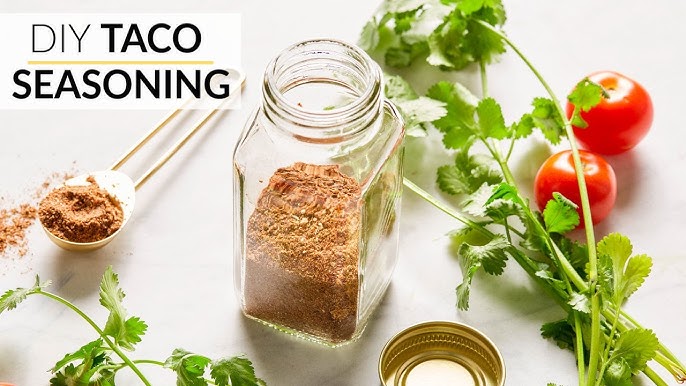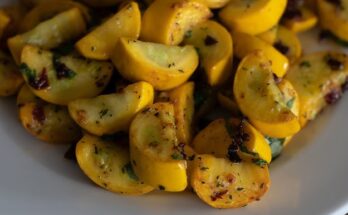Taco Seasoning Mix Recipe: If you’re anything like me, you probably love tacos more than life itself. And what’s a taco without that perfect, flavorful kick of taco seasoning? Instead of reaching for those store-bought packets filled with preservatives and unnecessary additives, why not whip up a homemade taco seasoning mix right in your kitchen? Trust me, it’s easy, it’s tasty, and you get full control over the flavor. Let’s walk through this step-by-step guide to creating your very own DIY taco seasoning mix that’s as bold or mild as you like.
What is Taco Seasoning?
Taco seasoning is a zesty and aromatic blend of spices used to flavor meats and vegetables, usually for tacos, burritos, or fajitas. Traditionally, it includes a combination of chili powder, cumin, paprika, garlic powder, onion powder, and oregano. These ingredients come together to form that familiar savory, smoky, and slightly spicy taste that’s synonymous with Tex-Mex cuisine. Whether you’re using ground beef, shredded chicken, or plant-based protein, taco seasoning brings the dish to life.
It’s not just for tacos, though. You can sprinkle it on popcorn, stir it into soups, or use it to spice up a salad dressing. Its versatility is unmatched, which makes it a must-have in any kitchen.
Why Make Homemade Taco Seasoning?
Great question! Homemade taco seasoning isn’t just about flavor—it’s about control. With store-bought packets, you’re often getting a dose of preservatives, anti-caking agents, and unnecessary fillers like cornstarch and MSG. Not ideal.
When you make it at home:
- You control the heat – Add more cayenne for a fiery kick or tone it down for kids.
- You save money – Spices in bulk are way cheaper in the long run.
- You avoid allergens – Gluten-free, dairy-free, and preservative-free? Yes, please!
- You get fresher flavor – Ground spices lose potency over time; fresh blends taste better.
Ingredients You’ll Need
Core Spices for the Perfect Blend
Let’s get into the heart of your homemade mix—the spices. Here’s the basic blend that creates a traditional taco flavor:
- 2 tablespoons chili powder
- 1 tablespoon ground cumin
- 1 teaspoon smoked paprika (or regular)
- 1 teaspoon garlic powder
- 1 teaspoon onion powder
- ½ teaspoon dried oregano
- ½ teaspoon crushed red pepper flakes (optional for heat)
- 1 teaspoon sea salt
- ½ teaspoon black pepper
Each of these ingredients brings something special to the party. Chili powder forms the base with its rich, warm flavor. Cumin adds that earthy, slightly nutty taste that makes taco seasoning unique. Garlic and onion powder bring savory depth, while oregano introduces a subtle herbal note. Salt and pepper round it all out.
Optional Add-Ins for Customization
One of the best parts of DIY seasoning is personalizing it. Depending on your taste preferences or the dishes you’re making, consider adding:
- ¼ teaspoon cinnamon – Adds a warm background note, often used in Mexican cuisine.
- 1 teaspoon cocoa powder – Unusual, but gives a deep, mole-like richness.
- ½ teaspoon sugar or brown sugar – Balances acidity and spice.
- ½ teaspoon cornstarch – Helps thicken sauces when mixed with liquids.
- Lime zest or lemon zest – Add right before serving for a citrusy lift.
Want to keep it low-sodium? Skip the salt entirely and season your dishes separately. Going keto? Ensure no sugar or cornstarch sneaks in.
Tools and Equipment Needed
Kitchen Tools to Gather
You don’t need fancy kitchen gadgets to make taco seasoning—just the basics:
- Measuring spoons – Precision matters when blending spices.
- Small mixing bowl – For stirring your blend.
- Whisk or spoon – To mix everything evenly.
- Funnel (optional) – Makes transferring the seasoning to containers easy.
- Spice grinder (optional) – If you’re using whole spices or want an ultra-fine blend.
Everything here should be in a standard kitchen. If not, they’re cheap to get and worth the investment for any home cook.
Storage Containers for Longevity
After mixing, you’ll need somewhere to store your spice mix. The right container can extend the shelf life of your seasoning by months.
- Glass spice jars with airtight lids – Best for preserving freshness.
- Mason jars – Great for bulk batches.
- Reusable zip bags – Work in a pinch, but not ideal for long-term storage.
Label your jar with the name and date—yes, you’ll thank yourself later! Keep the jar in a cool, dry, and dark place like a pantry or cabinet, away from direct sunlight and moisture.
Step-by-Step Instructions to Make Taco Seasoning
Step 1 – Measure Your Ingredients Accurately
Precision matters in spice blends. Start by laying out your spices and measuring each one carefully using a level spoon. Don’t eyeball it—you want consistency, especially if you’re planning to make a big batch or share the mix with friends.
Tips:
- Always use dry measuring spoons.
- Level off each spoon with a flat knife or your finger.
- Measure over the bowl in case of spills.
If you’re doubling or tripling the recipe, it’s smart to write down the new quantities so you don’t mix things up halfway.
Step 2 – Mixing and Blending Techniques
Once all your ingredients are measured and in the bowl, mix thoroughly using a whisk or spoon. The goal is to ensure every spoonful of the final blend has an even distribution of each spice.
Here’s how to get that perfect consistency:
- Stir in a circular motion for at least 1-2 minutes.
- Break up any clumps (especially with paprika or onion powder).
- Use a small sieve if you want an extra-fine texture.
Want an even finer blend? Toss everything into a spice grinder or mortar and pestle for 15-20 seconds.
Step 3 – Proper Storage Tips
Now that your mix is ready, transfer it into your chosen container using a funnel to avoid spills. Store in a cool, dark cupboard. Avoid keeping it near the stove or dishwasher, as heat and moisture can degrade the spices faster.
Here are some shelf-life hacks:
- Add a food-safe silica packet to absorb moisture.
- Store in smaller containers if you don’t use it all at once.
- Label the jar with “Taco Seasoning” and the date—it’s good for 6-12 months!
How to Use Taco Seasoning
Best Dishes to Use Taco Seasoning In
Taco seasoning isn’t just for tacos—nope, this flavor bomb is super versatile and can spice up a whole range of dishes. Of course, it shines brightest in classic ground beef tacos, but the possibilities are endless.
Here’s how you can put your homemade blend to work:
- Ground meat – Whether it’s beef, chicken, turkey, or pork, taco seasoning adds depth and warmth.
- Vegetarian options – Sprinkle on sautéed mushrooms, tofu, tempeh, or roasted chickpeas for a meatless taco night.
- Soups and stews – Stir a tablespoon into chili or tortilla soup for extra dimension.
- Beans and rice – A dash here transforms bland beans and rice into fiesta-worthy sides.
- Roasted veggies – Toss cauliflower, potatoes, or bell peppers with olive oil and taco seasoning before roasting.
- Eggs – Add to scrambled eggs or an omelet for a smoky Tex-Mex twist.
- Popcorn topping – Combine with a bit of melted butter or olive oil for a zesty movie snack.
It’s all about experimenting. This seasoning is your kitchen’s MVP, ready to transform any dish into something crave-worthy.
Adjusting Quantities per Recipe
A standard taco seasoning packet from the store usually equals about 2 to 3 tablespoons. This amount is typically meant to season 1 pound of meat. So, when using your homemade mix, keep that ratio in mind.
Want to make things even easier? Mix a big batch and divide it into “single-use” portions:
- 3 tablespoons = 1 seasoning pack
- Label small jars or plastic containers with pre-measured servings
- Keep a scoop in your jar for quick measurements
For stronger flavor, bump it up to 4 tablespoons. For something milder, 1.5 tablespoons works well. Always taste and tweak. You’re the boss in this kitchen.
Health Benefits of Homemade Seasoning
Say Goodbye to Preservatives
One of the biggest benefits of making your own taco seasoning? No mysterious ingredients. Store-bought packets often contain anti-caking agents, MSG, and preservatives to extend shelf life. While not all of these are inherently harmful, many people prefer to avoid them.
Here’s a side-by-side of what you typically find:
| Ingredient | Store-Bought Packet | Homemade Version |
|---|---|---|
| Salt | High volume | Controlled amount |
| MSG | Often included | Optional or excluded |
| Cornstarch | Used as filler | Not needed |
| Artificial Colors | Sometimes present | None |
| Natural Spices | Limited transparency | 100% transparency |
Making it yourself means you’re in control. You can avoid unnecessary additives and still get bold, punchy flavor.
Control Over Sodium and Sugar
Another reason to ditch the packet? Sodium content. Most commercial taco seasonings contain 300–400 mg of sodium per tablespoon. Multiply that by 2-3 tablespoons, and you’re getting over 1,000 mg in just one dish!
With homemade taco seasoning:
- You decide how much salt to use.
- You can cut it entirely if needed.
- No added sugars sneak in.
If you’re watching your sodium intake due to high blood pressure or other health reasons, this is a game-changer. Same goes for anyone on a keto, Whole30, or low-carb diet—no hidden sugars or starches here.
Cost Comparison: Store-Bought vs. Homemade
Savings Breakdown
You might be surprised to find out how much you can save with DIY seasoning. Let’s break it down.
Store-Bought:
- A single taco seasoning packet = $1.00 (on average)
- One packet = ~3 tablespoons
- Price per tablespoon = ~$0.33
Homemade (bulk spices bought once):
- Chili powder (1 lb) = $4.50
- Cumin (1 lb) = $5.00
- Paprika (1 lb) = $4.00
- Garlic/onion powder, oregano, salt, pepper = $10 total
You’ll spend about $25 upfront for bulk spices, but that gives you enough for over 50 batches of taco seasoning. That breaks down to about $0.10 per batch—and it’s fresher and tastier.
Over time, you could save hundreds of dollars, especially if taco night is a weekly tradition at your house.
Quality Over Quantity
Aside from the price, let’s talk about value. When you make it yourself, you’re not paying for fillers or packaging. You’re getting:
- Higher-quality spices
- Freshness that lasts longer
- A more potent flavor profile
You’ll use less per recipe because it’s stronger than the diluted store stuff. It’s like choosing a custom meal from a chef instead of grabbing fast food—night and day difference.
Shelf Life and Storage Tips
How Long Does It Last?
Homemade taco seasoning can last a surprisingly long time if stored correctly. The key here is to keep it dry, airtight, and out of direct sunlight.
On average, your mix will stay fresh for 6 months to 1 year. After that, it won’t go “bad” in the sense of spoiling, but the flavors will start to fade. Spices lose their punch over time, especially if they’re exposed to air and moisture.
Signs Your Seasoning Has Expired
Wondering if your taco seasoning has outlived its best days? Here are a few signs:
- Faded color – Bright red paprika turns dull brownish.
- Weak aroma – If it doesn’t smell fragrant when you open the jar, it’s past prime.
- Clumping – This could indicate moisture contamination. Toss it out.
To keep it fresher longer:
- Store in a glass jar with an airtight lid.
- Avoid plastic containers if possible (they can absorb odors).
- Don’t leave the lid off longer than necessary.
Flavor Variations to Try
Spicy Taco Seasoning Version
Love that fiery kick that makes your eyes water and your taste buds dance? Spicy taco seasoning is your jam. Customizing your seasoning for extra heat is easy and totally worth it. When you DIY your blend, you’re not stuck with the mild middle-of-the-road heat from store-bought options.
To turn up the heat:
- Add 1 teaspoon cayenne pepper – Packs a serious punch.
- Increase crushed red pepper flakes to 1 teaspoon.
- Use chipotle chili powder instead of regular chili powder for a smoky heat.
This version is perfect for spicy beef tacos, grilled chicken, or adding a firecracker twist to beans and rice. Pro tip: make a separate jar labeled “Hot” so you don’t accidentally scorch your dinner.
For extreme heat lovers, you can experiment with ground ghost pepper or habanero powder—but tread lightly! A little goes a long way.
Mild and Kid-Friendly Version
Cooking for kids or someone with a sensitive palate? You can still enjoy the classic taco flavor without the burn. A mild taco seasoning has all the warm, rich spices, just toned down in the heat department.
Here’s how to make it mild:
- Skip cayenne pepper entirely
- Limit or omit red pepper flakes
- Add ½ teaspoon brown sugar for a slightly sweet balance
- Increase garlic and onion powder to enrich the flavor
This version is ideal for family taco nights, meal-prepped lunches, or even taco-flavored casseroles. It gives you the essence of a taco without any complaints about “it’s too spicy!”
It’s also great for introducing kids to bold flavors without overwhelming them. And let’s be honest, even some adults prefer their tacos with less of a flame.
Common Mistakes to Avoid
Overpowering with One Spice
One of the most common mistakes people make when crafting their taco seasoning is letting one spice dominate the whole blend. Maybe it’s too much cumin, or a heavy hand with the chili powder—it throws everything off-balance.
Avoid this by:
- Always measuring your spices (no guesstimates!)
- Tasting a small sample with a neutral base (like sour cream or broth)
- Keeping a consistent base formula, then customizing small batches
Remember, spices are like instruments in a band—they all have to work together to create harmony. No one wants a solo act when you’re expecting a full orchestra.
Incorrect Storage
Storing your spice mix improperly can lead to a whole lot of disappointment later on. Moisture, air, and light are the enemies of freshness.
Here’s what NOT to do:
- Don’t store in plastic bags long-term
- Don’t keep it near the stove or windows
- Don’t forget to label it—expiration dates are your friend
And always, always use dry utensils when scooping from the jar. A damp spoon is the fastest way to ruin your whole batch.
Correct storage isn’t just about keeping your taco seasoning “good”—it’s about keeping it delicious. Don’t cut corners here.
FAQs About Taco Seasoning Mix Recipe
1. What is taco seasoning mix made of?
Taco seasoning typically includes chili powder, cumin, paprika, garlic powder, onion powder, oregano, salt, and black pepper. Some variations may add cayenne pepper for heat or a touch of sugar for balance.
2. Is taco seasoning spicy?
It can be! Most store-bought blends are mild to medium, but if you’re making it at home, you can easily adjust the heat level by adding more or less cayenne pepper or crushed red pepper flakes.
3. How much homemade taco seasoning equals one packet?
One standard packet of taco seasoning is about 2 to 3 tablespoons. Use this amount when substituting homemade seasoning in recipes.
4. Can I make a large batch of taco seasoning?
Absolutely. Homemade taco seasoning stores well in an airtight container for up to 6 months. Make a big batch and scoop out what you need each time—it saves time and reduces waste.
5. Is taco seasoning gluten-free?
Most homemade taco seasoning recipes are gluten-free, as they use only herbs and spices. However, always check the labels of store-bought versions or spice brands if you’re avoiding gluten.
6. How do I use taco seasoning?
Brown your ground meat (like beef, chicken, or turkey), then add taco seasoning along with a splash of water. Simmer for a few minutes to let the flavors blend. It’s also great for vegetables, soups, or rice.
7. Can I use taco seasoning for more than just tacos?
Yes! It works well in chili, soups, casseroles, fajitas, nachos, and even roasted vegetables. It’s a versatile spice blend that adds bold flavor to many dishes.
Conclusion
Making your own taco seasoning mix is one of those small kitchen habits that pays off big. It’s fresher, more flavorful, and way healthier than store-bought packets. Whether you’re going spicy, mild, or somewhere in between, you’ve got full control over every ingredient. Plus, you’ll save money in the long run and get a better product every time.
This isn’t just a seasoning—it’s your ticket to next-level tacos, soups, veggies, and more. Once you make your own, you’ll never look back.
So go ahead, mix up a batch today and transform your kitchen into a flavor fiesta.



